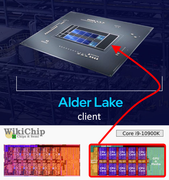|
McG
Datum registracije: Feb 2014
Lokacija: Varaždin
Postovi: 8,216
|
Citiraj:
Intel rebadges 10nm Enhanced SuperFin node as "Intel 7," invents other creative node names
Citiraj:
Intel, in a move comparable to its competitors' Performance Rating system from the 1990s, has invented a new naming scheme for its in-house foundry nodes to claim technological parity with contemporaries such as TSMC and Samsung, that are well into the sub-10 nm class. Intel's new foundry naming system sees its 10 nm Enhanced SuperFin node re-badge as "Intel 7." The company currently builds 11th Gen Core "Tiger Lake" processors on the 10 nm SuperFin node, and is expected to build its upcoming 12th Gen Core "Alder Lake" chips on its refinement, the 10 nm Enhanced SuperFin, which will now be referred to as "Intel 7." The company is careful to avoid using the nanometer unit next to the number, instead signaling the consumer that the node somehow offers transistor density and power characteristics comparable to a 7 nm node. Intel 7 offers a 10-15 percent performance/Watt gain over 10 nm SuperFin, and is already in volume production, with a debut within 2021 with "Alder Lake."
This is where things get interesting. The successor to Intel 7 is named Intel 4, and is technically a 7 nm EUV node. This node offers a 20 percent performance/Watt gain over Intel 7 (aka 10 nm Enhanced SuperFin), and will debut in mid-2022 with "Meteor Lake" client- and "Granite Rapids" enterprise processors. Intel has gone with "4" for the name as 2022 sees both Samsung and TSMC roll out their sub-5 nm nodes. , while Samsung will hopefully iron out its , and ramp up 4 nm, by 2022. Intel 3 succeeds Intel 4 in the second half of 2023, and is timed to launch around the time TSMC comes out with its sub-4 nm node, likely the 2 nm. Intel claims this node offers an 18 percent performance/Watt gain over the Intel 4, implement a denser HP library, increase the use of EUV, improve the drive-current and via resistance, to result in the performance/Watt target. With no mention of FET size, it's very likely that Intel 3 is still a 7 nm node.
It's only in 2024 that Intel is promising major technological breakthroughs, with Intel 20A, heralding the era in silicon fabrication where transistor sizes are measured in Angstroms (0.1 nm). 20A would hence be a creative way of saying 2 nm. Intel will introduce a brand new transistor design it calls the RibbonFET. It remains to be seen if this is a whole new innovation or similar to nanosheet FETs. Intel is also announcing PowerVia, a revolutionary new way to connect silicon dies with each other, or with the package, which debuts with the Intel 20A node. The company is targeting a 1H-2024 debut of this new node.
With these, Intel is ensuring that it has a new node to offer each year leading up to 2024, each with a double-digit percent performance/Watt gain, so the company can restore something resembling its "Tick-Tock" product development cadence, enabling it to compete not just against AMD, but also the emergence of serious Arm-powered rivals, such as nVidia, Qualcomm, and Apple. The company is hence facing similar levels of competition as the early 1990s. x86 may no longer have a stranglehold over the PC, as Arm-powered rivals claw away at market-share with efficient and fairly-powerful chips.
|
Izvor: TechPowerUp
 
|
Izgleda da je u Intelu izmišljanje tople vode svakih par godina na repertoaru: Intel’s Manufacturing Roadmap from 2019 to 2029: Back Porting, 7nm, 5nm, 3nm, 2nm, and 1.4 nm
I sad su to sve fino bacili u vodu i OK, nek imaju nazive kakve god žele, ali za par godina bi opet mogli izmisliti neke nove, kad se i ovaj plan izjalovi.
Novi CEO u ovom webcastu djeluje toliko vjerodostojno da ga je teško gledati i slušati dok recitira skriptirane materijale s glumatanjem i lažnim uzbuđenjem za nove proizvode i procese.
I po svemu sudeći, Alder Lake i dalje koristi dosadašnji monolitan dizajn za tzv. big.LITTLE implementaciju, odnosno nema naznaka chiplet/tiles pristupu, to su (u ovoj generaciji) rezervirali za Sapphire Rapids. 
__________________
AMD Ryzen 9 9950X | Noctua NH-U12A chromax.black | MSI MAG B650 Tomahawk Wi-Fi | 128GB Kingston FURY Beast DDR5-5200 | 256GB AData SX8200 Pro NVMe | 2x4TB WD Red Plus | Fractal Define 7 Compact | Seasonic GX-750
AMD Ryzen 5 7600 | Noctua NH-U12A chromax.black | MSI MAG B650 Tomahawk Wi-Fi | 128GB Kingston FURY Beast DDR5-5200 | 256GB AData SX8200 Pro NVMe | 2x12TB WD Red Plus | Fractal Define 7 Compact | eVGA 650 B5
Zadnje izmijenjeno od: The Exiled. 27.07.2021. u 00:43.
|